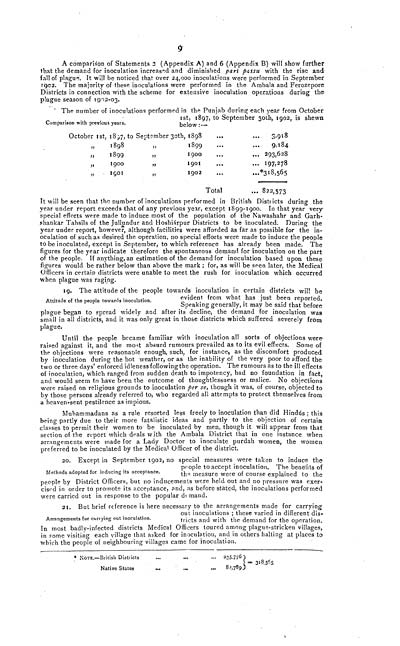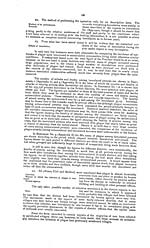Medicine - Disease > Report on plague in the Punjab from October 1st ... to September 30th ..., being the ... season of plague in the province
(23) Page 9
Download files
Individual page:
Thumbnail gallery: Grid view | List view

9
A comparison of Statements 2 (Appendix A) and 6 (Appendix B) will show further
that the demand for inoculation increased and diminished part passu with the rise and
fall of plague. It will be noticed that over 24,000 inoculations were performed in September
1902. The majority of these inoculations were performed in the Ambala and Ferozepore
Districts in connection with the scheme for extensive inoculation operations during the
plague season of 1902-03.
Comparison with previous years.
The number of inoculations performed in the Punjab during each year from October
1st, 1897, to September 30th, 1902, is shewn
below:-
October 1st,
1897,
to September 30th,
1898
3,918
,,
1898
,,
1899
9,184
,,
1899
,,
1900
293,628
,,
1900
,,
1901
197,278
,,
1901
,,
1902
*318,565
Total
822,573
It will be seen that the number of inoculations performed in British Districts during the
year under report exceeds that of any previous year, except 1899-1900. In that year very-
special efforts were made to induce most of the population of the Nawashahr and Garh-
shankar Tahsils of the Jullundur and Hoshiarpur Districts to be inoculated. During the
year under report, however, although facilities were afforded as far as possible for the in-
oculation of such as desired the operation, no special efforts were made to induce the people
to be inoculated, except in September, to which reference has already been made. The
figures for the year indicate therefore the spontaneous demand for inoculation on the part
of the people. If anything, an estimation of the demand for inoculation based upon these
figures would be rather below than above the mark ; for, as will be seen later, the Medical
Officers in certain districts were unable to meet the rush for inoculation which occurred
when plague was raging.
Attitude of the people towards inoculation.
19. The attitude of the people towards inoculation in certain districts will be
evident from what has just been reported.
Speaking generally, it may be said that before
plague began to spread widely and after its decline, the demand for inoculation was
small in all districts, and it was only great in those districts which suffered severely from
plague.
Until the people became familiar with inoculation all sorts of objections were-
raised against it, and the most absurd rumours prevailed as to its evil effects. Some of
the objections were reasonable enough, such, for instance, as the discomfort produced
by inoculation during the hot weather, or as the inability of the very poor to afford the
two or three days' enforced idleness following the operation. The rumours as to the ill effects
of inoculation, which ranged from sudden death to impotency, had no foundation in fact
and would seem to have been the outcome of thoughtlessness or malice. No objections
were raised on religious grounds to inoculation per se, though it was, of course, objected to
by those persons already referred to, who regarded all attempts to protect themselves from
a heaven-sent pestilence as impious.
Muhammadans as a rule resorted less freely to inoculation than did Hindus ; this
being partly due to their more fatalistic ideas and partly to the objection of certain
classes to permit their women to be inoculated by men, though it will appear from that
section of the report which deals with the Ambala District that in one instance when
arrangements were made for a Lady Doctor to inoculate purdah women, the women
preferred to be inoculated by the Medical Officer of the district.
Methods adopted for inducing its acceptance.
20. Except in September 1902, no special measures were taken to induce the
people to accept inoculation. The benefits of
the measure were of course explained to the
people by District Officers, but no inducements were held out and no pressure was exer-
cised in order to promote its acceptance, and, as before stated, the inoculations performed
were carried out in response to the popular demand.
Arrangements for carrying out inoculation.
21. But brief reference is here necessary to the arrangements made for carrying
out inoculations ; these varied in different dis-
tricts and with the demand for the operation.
In most badly-infected districts Medical Officers toured among plague-stricken villages,
in some visiting each village that asked for inoculation, and in others halting at places to
which the people of neighbouring villages came for inoculation.
* NOTE.-
British Districts
235,776
318,565
Native States
82,789
A comparison of Statements 2 (Appendix A) and 6 (Appendix B) will show further
that the demand for inoculation increased and diminished part passu with the rise and
fall of plague. It will be noticed that over 24,000 inoculations were performed in September
1902. The majority of these inoculations were performed in the Ambala and Ferozepore
Districts in connection with the scheme for extensive inoculation operations during the
plague season of 1902-03.
Comparison with previous years.
The number of inoculations performed in the Punjab during each year from October
1st, 1897, to September 30th, 1902, is shewn
below:-
October 1st,
1897,
to September 30th,
1898
3,918
,,
1898
,,
1899
9,184
,,
1899
,,
1900
293,628
,,
1900
,,
1901
197,278
,,
1901
,,
1902
*318,565
Total
822,573
It will be seen that the number of inoculations performed in British Districts during the
year under report exceeds that of any previous year, except 1899-1900. In that year very-
special efforts were made to induce most of the population of the Nawashahr and Garh-
shankar Tahsils of the Jullundur and Hoshiarpur Districts to be inoculated. During the
year under report, however, although facilities were afforded as far as possible for the in-
oculation of such as desired the operation, no special efforts were made to induce the people
to be inoculated, except in September, to which reference has already been made. The
figures for the year indicate therefore the spontaneous demand for inoculation on the part
of the people. If anything, an estimation of the demand for inoculation based upon these
figures would be rather below than above the mark ; for, as will be seen later, the Medical
Officers in certain districts were unable to meet the rush for inoculation which occurred
when plague was raging.
Attitude of the people towards inoculation.
19. The attitude of the people towards inoculation in certain districts will be
evident from what has just been reported.
Speaking generally, it may be said that before
plague began to spread widely and after its decline, the demand for inoculation was
small in all districts, and it was only great in those districts which suffered severely from
plague.
Until the people became familiar with inoculation all sorts of objections were-
raised against it, and the most absurd rumours prevailed as to its evil effects. Some of
the objections were reasonable enough, such, for instance, as the discomfort produced
by inoculation during the hot weather, or as the inability of the very poor to afford the
two or three days' enforced idleness following the operation. The rumours as to the ill effects
of inoculation, which ranged from sudden death to impotency, had no foundation in fact
and would seem to have been the outcome of thoughtlessness or malice. No objections
were raised on religious grounds to inoculation per se, though it was, of course, objected to
by those persons already referred to, who regarded all attempts to protect themselves from
a heaven-sent pestilence as impious.
Muhammadans as a rule resorted less freely to inoculation than did Hindus ; this
being partly due to their more fatalistic ideas and partly to the objection of certain
classes to permit their women to be inoculated by men, though it will appear from that
section of the report which deals with the Ambala District that in one instance when
arrangements were made for a Lady Doctor to inoculate purdah women, the women
preferred to be inoculated by the Medical Officer of the district.
Methods adopted for inducing its acceptance.
20. Except in September 1902, no special measures were taken to induce the
people to accept inoculation. The benefits of
the measure were of course explained to the
people by District Officers, but no inducements were held out and no pressure was exer-
cised in order to promote its acceptance, and, as before stated, the inoculations performed
were carried out in response to the popular demand.
Arrangements for carrying out inoculation.
21. But brief reference is here necessary to the arrangements made for carrying
out inoculations ; these varied in different dis-
tricts and with the demand for the operation.
In most badly-infected districts Medical Officers toured among plague-stricken villages,
in some visiting each village that asked for inoculation, and in others halting at places to
which the people of neighbouring villages came for inoculation.
* NOTE.-
British Districts
235,776
318,565
Native States
82,789
Set display mode to: Large image | Zoom image | Transcription
Images and transcriptions on this page, including medium image downloads, may be used under the Creative Commons Attribution 4.0 International Licence unless otherwise stated. ![]()
| India Papers > Medicine - Disease > Report on plague in the Punjab from October 1st ... to September 30th ..., being the ... season of plague in the province > (23) Page 9 |
|---|
| Permanent URL | https://digital.nls.uk/74579350 |
|---|




